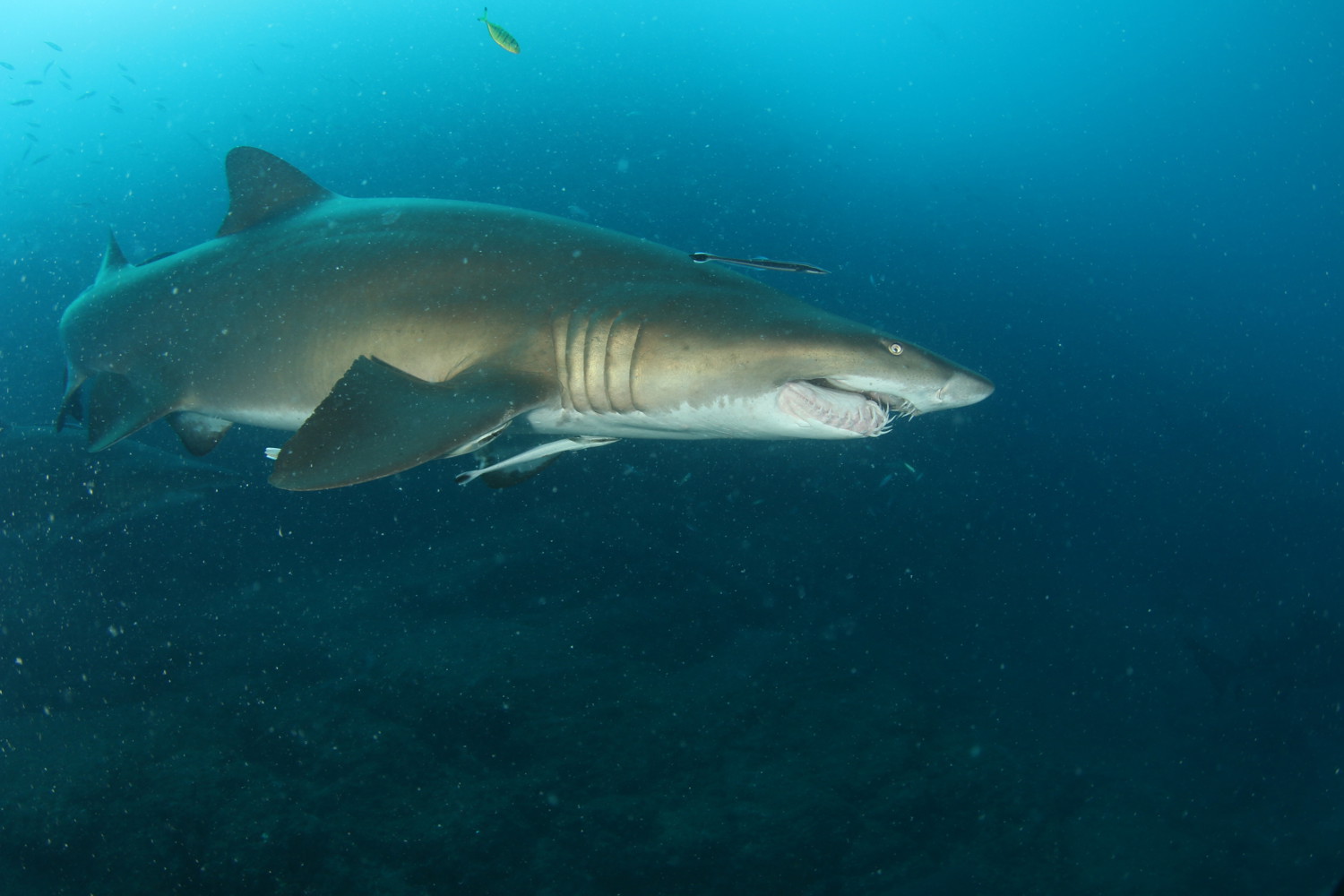From grey nurse sharks in Moreton Bay and birds of prey on K’gari to manta rays off Cairns and sawfish in Cape York – UniSC has gained new funding for research and citizen science projects to help protect some of the state’s most iconic and threatened species.
UniSC researchers will share in more than $1.25 million from the Queensland Threatened Species Research Grants program to build on existing studies on shark and sawfish populations.
This includes research on aggregation sites for critically endangered grey nurse sharks near Moreton Bay, Wolf Rock at Double Island Point and Agnes Water, by UniSC Senior Lecturer in Animal Ecology Dr Ross Dwyer and UniSC shark researcher Dr Chris Dudgeon.
Dr Dwyer said despite its protection status and economic value of grey nurse shark diving to Queensland’s tourism industry, there was uncertainty of the current size of the east Australian population and whether conservation management strategies have translated into its recovery.
“Using the sharks’ unique spot patterns and photographic identification (photo-id) survey data spanning two decades, we will determine if the number of grey nurse sharks in Queensland waters has increased following protections, and if the incidence of fishing related injury has reduced,” he said.
“The overall aim is to establish a national photo database for grey nurse sharks that uses historical, current and future photo-identifications to monitor species abundance and trends, to quantify interactions with fishing gear, and to engage and educate dive shops, divers, and the public more broadly.”
Dr Dudgeon is also a co-investigator on a project titled, ‘’Finding the needle in a Haystack’ that has received a grant to determine the importance of a newly discovered whale shark aggregation in far north Queensland and the implications for their conservation.
Meanwhile, Dr Dwyer, UniSC Associate Professor Kathy Townsend and PhD candidate Nikki Biskis will work to identify the distribution and demography of freshwater sawfish populations in the Normanby River catchment. It is part of a collaboration with Sharks and Rays Australia, who has received a grant of almost $150,000 for the project.
“As part of this project, we’ll be working closely with the Laura, Rinyirru and Lama Lama Aboriginal Land and Sea Rangers to observe, survey and track freshwater sawfish. Our goal is to reveal which east coast river systems hold critical nursery habitat for sawfish, and to understand how sawfish move within these waterways,” Ms Biskis said.
“As part of this project, we’ll be working closely with the Laura, Rinyirru and Lama Lama Aboriginal Land and Sea Rangers to observe, survey and track freshwater sawfish. Our goal is to reveal which east coast river systems hold critical nursery habitat for sawfish, and to understand how sawfish move within these waterways,” Ms Biskis said.
Creating citizen scientists
Citizen science is the focus of three other exciting UniSC initiatives to receive Queensland Government—Engaging Science Grants, which were also announced recently.
The UniSC-led Project Manta research collaboration will use the funding to visit locations where manta rays are often seen, but researchers have little data about their movements and habitat use.
UniSC Research Fellow and Project Manta member Dr Asia Haines said citizen scientist input was crucial for monitoring these charismatic species along Queensland’s vast coastline.
The group will hold a series of events at the Whitsundays, Rainbow Beach, Bargara and Cairns to encourage residents to join manta ray conservation and protection efforts.
Another project will deliver workshops in the Sunshine Coast region to engage people with a disability in citizen science, led by Senior Lecturer in Tourism Dr Vikki Schaffer.
“Almost 1-in-5 Queenslanders have a disability, so designing citizen science activities for broad inclusion is needed,” said Dr Schaffer, who has designed the project to deliver two important goals.
“The workshops will provide an opportunity for people with disability to share and gain knowledge and skills while engaging in citizen science in the areas of astronomy and marine science,” she said.
"They will assist researchers to identify the components required for designing inclusive citizen science projects to increase scientific discoveries in fun and interesting ways.”
Citizen scientists will also be called on to capture images of K’gari’s iconic birds of prey as part of another UniSC project to receive funding support through the grants program.
With little known about the distribution and habitat of many of the wildlife species that live on or visit the world’s largest sand island, the project will empower citizen scientists to collect and map data, capture high-quality images and design and create social media campaigns on K’gari’s raptors.

“Manta rays are fantastic for engaging people in marine science and conservation, as they are large and charismatic, and people care about them. They provide the perfect vehicle for spreading the message about research and issues related to our oceans,” DrAsia Haines said.
Media enquiries: Please contact the Media Team media@usc.edu.au

